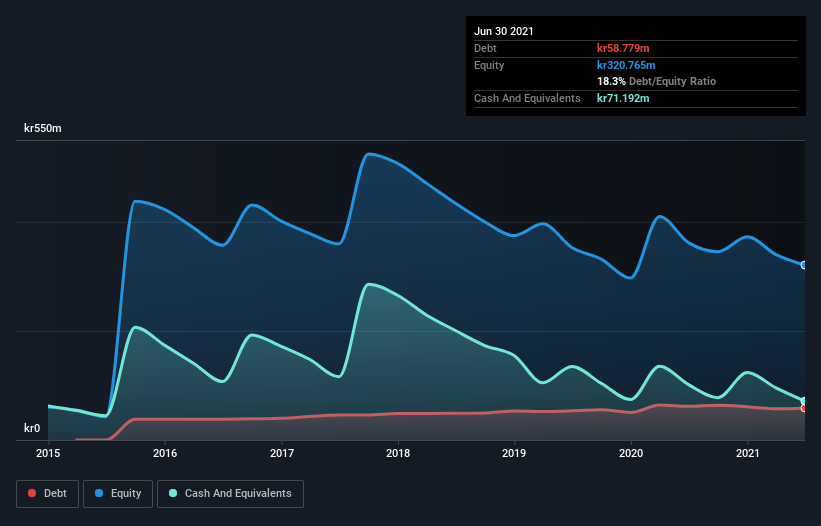
Some say volatility, rather than debt, is the best way to think about risk as an investor, but Warren Buffett famously said that 'Volatility is far from synonymous with risk.' It's only natural to consider a company's balance sheet when you examine how risky it is, since debt is often involved when a business collapses. Importantly, Targovax ASA (OB:TRVX) does carry debt. But the more important question is: how much risk is that debt creating?
What Risk Does Debt Bring?
Debt assists a business until the business has trouble paying it off, either with new capital or with free cash flow. Ultimately, if the company can't fulfill its legal obligations to repay debt, shareholders could walk away with nothing. While that is not too common, we often do see indebted companies permanently diluting shareholders because lenders force them to raise capital at a distressed price. Having said that, the most common situation is where a company manages its debt reasonably well - and to its own advantage. When we examine debt levels, we first consider both cash and debt levels, together.
See our latest analysis for Targovax
What Is Targovax's Net Debt?
The image below, which you can click on for greater detail, shows that Targovax had debt of kr58.8m at the end of June 2021, a reduction from kr61.7m over a year. However, its balance sheet shows it holds kr71.2m in cash, so it actually has kr12.4m net cash.

A Look At Targovax's Liabilities
The latest balance sheet data shows that Targovax had liabilities of kr20.5m due within a year, and liabilities of kr118.1m falling due after that. Offsetting these obligations, it had cash of kr71.2m as well as receivables valued at kr6.37m due within 12 months. So it has liabilities totalling kr61.0m more than its cash and near-term receivables, combined.
Given Targovax has a market capitalization of kr519.5m, it's hard to believe these liabilities pose much threat. However, we do think it is worth keeping an eye on its balance sheet strength, as it may change over time. While it does have liabilities worth noting, Targovax also has more cash than debt, so we're pretty confident it can manage its debt safely. The balance sheet is clearly the area to focus on when you are analysing debt. But ultimately the future profitability of the business will decide if Targovax can strengthen its balance sheet over time. So if you're focused on the future you can check out this free report showing analyst profit forecasts.
Given its lack of meaningful operating revenue, Targovax shareholders no doubt hope it can fund itself until it has a profitable product.
So How Risky Is Targovax?
By their very nature companies that are losing money are more risky than those with a long history of profitability. And we do note that Targovax had an earnings before interest and tax (EBIT) loss, over the last year. Indeed, in that time it burnt through kr94m of cash and made a loss of kr97m. But at least it has kr12.4m on the balance sheet to spend on growth, near-term. Summing up, we're a little skeptical of this one, as it seems fairly risky in the absence of free cashflow. There's no doubt that we learn most about debt from the balance sheet. However, not all investment risk resides within the balance sheet - far from it. For instance, we've identified 5 warning signs for Targovax (3 don't sit too well with us) you should be aware of.
At the end of the day, it's often better to focus on companies that are free from net debt. You can access our special list of such companies (all with a track record of profit growth). It's free.
New: AI Stock Screener & Alerts
Our new AI Stock Screener scans the market every day to uncover opportunities.
• Dividend Powerhouses (3%+ Yield)
• Undervalued Small Caps with Insider Buying
• High growth Tech and AI Companies
Or build your own from over 50 metrics.
This article by Simply Wall St is general in nature. We provide commentary based on historical data and analyst forecasts only using an unbiased methodology and our articles are not intended to be financial advice. It does not constitute a recommendation to buy or sell any stock, and does not take account of your objectives, or your financial situation. We aim to bring you long-term focused analysis driven by fundamental data. Note that our analysis may not factor in the latest price-sensitive company announcements or qualitative material. Simply Wall St has no position in any stocks mentioned.
Have feedback on this article? Concerned about the content? Get in touch with us directly. Alternatively, email editorial-team (at) simplywallst.com.
About OB:CRNA
Circio Holding
A biotechnology company, develops novel circular RNA and immunotherapy medicines.
Medium-low and good value.
Market Insights
Community Narratives



